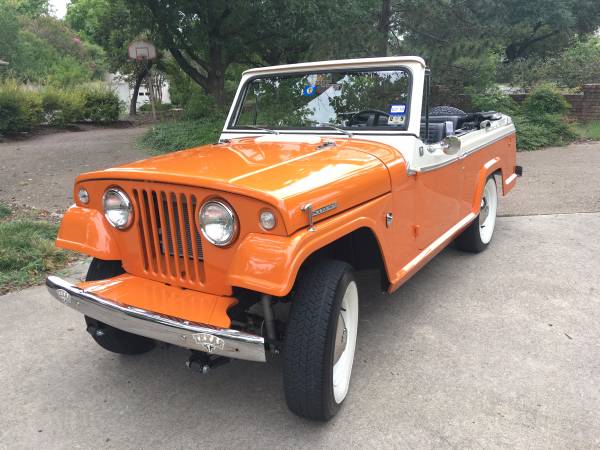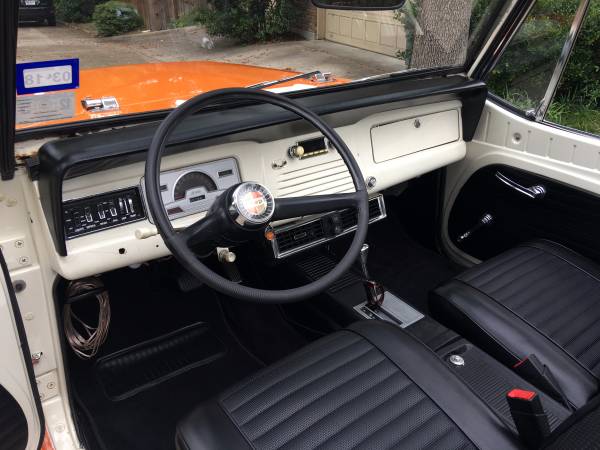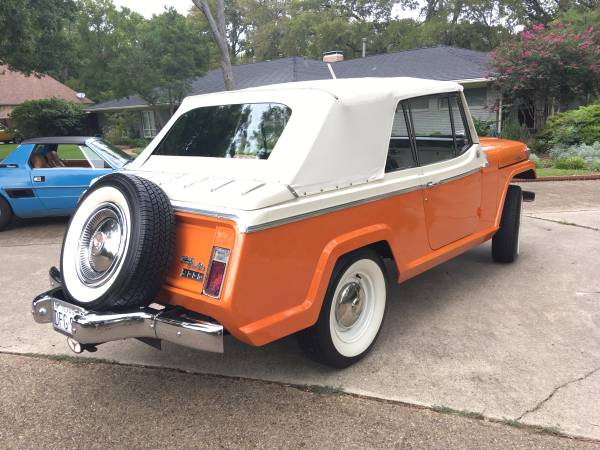Blaine shared this beautiful Jeepster Commando.
https://phoenix.craigslist.org/nph/cto/d/1967-kaiser-jeepster-commando/6283515119.html
“Take a look at this 1967 Jeepster Convertible! It comes with a reserved parking spot in the no sulk zone. It’s hard not to smile at the thought of jumping into this classic SUV for a Sunday cruise, to the Saturday tailgate or for a Tuesday grocery run. In fact this four seat convertible with a smooth running V6 motor and automatic transmission is a family favorite everyday of the week.
The Kaiser Jeepster was an updated interpretation of the Willys Jeepster which ended it’s production run in 1951. Introduced in 1966 the new line of Jeepster Commandos were aimed at the recently launched Ford Bronco and International Scout. Versatile in pickup, wagon and convertible configurations, they were offered with either an inline four or V6 engine, all had 4 wheel drive. The convertibles were the upscale versions with upgraded interiors, chrome accents and the exclusive Continental Tire kit. The early versions like this one retained the classic Jeep grill and front fender treatment, phased out in 1972 by a more modern squared off front end. The Jeepsters were discontinued in 1973.
This Jeepster received an extensive cosmetic and mechanical refresh over a several year period. It isn’t flawless but it presents extremely well and will draw attention everywhere it goes. This car is completely sorted mechanically and drives out perfectly. The carpet, upholstery and top were all replaced with high quality materials. Sporting its original “Dauntless” V6 motor, 3-speed Turbo Hydromatic transmission and working air conditioner, makes this classic Jeepster accessible to drivers who prefer a more civilized and comfortable cruiser. Its working 4 wheel drive however make it ideal for outdoor adventure and country living.
The Jeepster effectively bridged eras, in its day offering classic retro styling with modern mechanical underpinnings. The formula still works today. Like all Jeeps, they just seem to make us smile. Got the blues? Diving a Jeepster is an unusual but reliable tonic to transport you into the no sulk zone!”





Notice the “EXTRA LARGE” air filter on this V/6, I have never seen a paper type this big on a V/6. More air flow, better performance, is that the reason? I would think more air intake would effect the carburetor fuel/air adjustment. Technical questions, but really interested in knowing the answers.
Less restriction = more air flow, but I don’t think it would effect fuel/air mixture to any noticeable extent.
It allows more airflow at high RPMs. For that V6 I think it would need to reach 5000 rpm before you see a benefit.
A very nicely done Jeepster Commando!
Probably went that way due to the A/C plumbing on the right side vs the intake snout. Runs a bit close to the body at the top rear edge.
But still really purrrrrty!!!
Anyone know what the part is on the front crossmember that you can see in picture 16 of 24 on the craigslist site listing? Did these have a center point steering similar to the CJ or DJ Jeeps? Well it wasn’t quite center point but close. I noticed that this steering system has a damper attached to the tie rod, which usually indicates an attempt to correct shimmy in the steering.
Seems that the early Jeepsters and the later ones tend to be pricey.
If any of you see MB Jeeps with camouflage paint schemes and are told this is as original be very skeptic. I saw one for sale for about $19,000 with the claim that this was or is an accurate restoration. I called my Uncle Richard in Reading, PA and he confirms that military Jeeps during WW2 (he was in the Army Air Corp) were painted three primary solid colors; olive drab (almost like Bell Telephone green), gray, and sand. In the 1950s when the Air Force was created they started painting Jeeps a flat dark blue. All the colors were flat. Sand was evidently what was used in North Africa, gray was used by the Navy, and olive drab was used by the Army (infantry including the Marines). My uncle confirmed that there were no camouflage paint schemes. He told me that if there were they would have painted a number of airplanes in a camouflage scheme. My uncle was the youngest boy in his family and he is now or will be 97, still drives a car and plays golf.
Mike: The carburetor air flow is controlled by the venturi and throttle plate at the bottom of the carburetor. The carburetor throat may be up inside the bottom of the air cleaner. The underside of the lower air filter mounting plate may fit down over the carburetor body somewhat. Only when the air filter doesn’t match the air flow requirements would the size be a problem. That may not be the original air cleaner. In 1966-67 most automobiles had preheaters from the exhaust manifold to the air cleaner snout to provide warm air when starting. Then when it was sufficiently warmed up the flap in the snout would begin to open allowing in cooler air. The entire air filter was enclosed in a can. In addition there was a hose from the clean air side of the air cleaner that supplied clean filtered air to the valve cover for the P.C.V. system. This was the beginning of some of the early emissions controls. My hand-me-down 1967 Mercury Comet had such a system and kept the carb from icing when the weather was cool and humid.
Paul, I must say, I agree with you completely factual information is always valued, Thank you. In response to your statements, I bought a 1967 Jeepster Commando new and it had wheel shimmy from the day I drove it home from the dealer. Glad you pointed out picture 16, I missed that.
The military “restoration” thing has gotten way out of hand, too many experts who don’t know what they are talking about. Growing up in the 1950’s, the color schemes you mentioned, are the only ones I remember as being correct.
Your explanation of air, gas mixture in the carburetor and it’s functioning was was the most comprehensive and understandable I have ever read. We think alike, thanks, Mike
Mike,
I found a repair manual online and that bracket in picture 16 is the original center point steering mount. The steering gear to the right in the picture is a newer Saginaw steering gear mounted out front near the front crossmember (saw an installation online). If this were my Jeep I would put in a Saginaw recirculating ball and nut steering gear where the original was mounted. Some of the Saginaw boxes used in Studebaker Larks would probably be a bolt in replacement for the Ross gear. In fact in the Studebaker Larks the Saginaw was the replacement for the Ross steering gears. Lots of rotten Larks lying around that would give up their Saginaw steering gear. I think some of the preferred hot rod steering boxes were also Saginaw recirculating ball and nut steering gears. Might be able to get them new from some of the hot rod parts dealers like Speedway.
Your shimmy might have been caused by a poor caster adjustment, i.e. not enough caster. Seems that changing the steering gear didn’t solve the shimmy in this one otherwise there would be no need for the damper. Shimmy can also be caused by worn parts in the steering system, bent wheels, tires that are not running true, wheel balance issues or bent front spindles. Bent axle shafts can also contribute to the feeling of shimmy as well as worn spring eye bushings and incorrect toe-in. All it takes is one side to produce the shimmy. With the solid axle housing and track rod connecting both sides one side gets transferred to the other side. That is why GM abandoned the solid axle in all GM cars in the period between 1933 and 1935. You can still get some shimmy in independent front suspensions but that is handled with a bit of friction in the king pins and tie rod ends.
Paul,
Great information, you obviously have a vast automotive knowledge and I thank you for sharing it with “backyard mechanics” like me. Might I add that your explanations are clear and precise, easy to understand. I appreciate your contributions to this page.
We have a 1967 Jeepster that we are thinking of selling. It is in running condition some body damage due to age but when we go on the road with it, it draws a lot of attention. Any idea of where we should start advertising.
Hi Joe,
There are a few different places I’d recommend. I’m happy to list it at eWillys if you’d like (costs nothing .. email me at d@ewillys.com for more info). Your local Craigslist is a good place. eBay can be a good place. And, the Jeepster Commando Club of America could be a good place: http://jeepstercommandoclub.com
– Dave